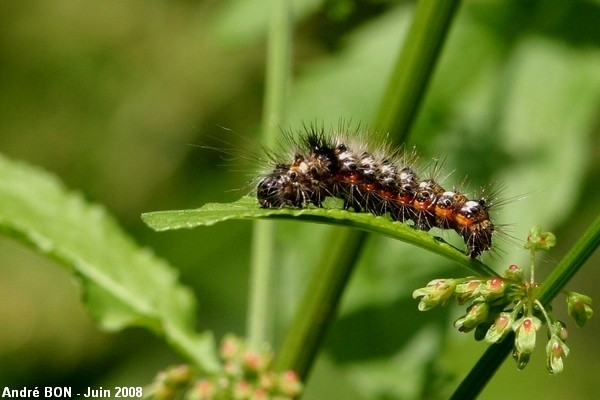
| Yellow-tail Moth (Euproctis similis (Fuessly, 1775)) |

|
|
Scientific name: Euproctis similis (Fuessly, 1775) Common name: Yellow-tail Moth French name: Bombyx cul-doré, Cul doré. Order: Lepidoptera Suborder: Heterocera Family: Erebidae Subfamily: Lymantriinae Wingspan: 32 to 40 mm, females are slightly larger than males. Biotope: Forests, woodland edges, parks and gardens. Geographic area: Europe and Asia except extreme northern areas, east to Japan. Flight time: June to August. Number of generations : 1 Caterpillar: Black with protruding white patches, a black head and long whitish bristles. There is a lateral bright red stripe and an orange broken dorsal stripe. The dorsal stripe is longitudinally crossed by a black line. It shows a black hairy protuberance on the rear side of the head, near segments 4 and 5. It also shows a small black protuberance near segment 11. The caterpillar of the Brown-tail Moth (Euproctis chrysorrhoea) has long reddish dorsal bristles. Host plant: Many deciduous trees and shrubs, Oaks (Quercus sp.), Birches (Betula sp.), Elms (Ulmus sp.), Hawthorns (Crataegus sp.), Willows (Salix sp.), etc. |
The abdomen of the Yellow-tail Moth is white with a tuft of golden brown hairs on the tip. It has a hairy look. The wings are pure white. Males show black marks on the back edges of the forewings. The antennae of males are very strongly feathery, those of females are much less so. The Yellow-tail Moth is attracted to light. It over winters as a caterpillar at an intermediate development stage. There is a possible confusion with the Brown-tail Moth (Euproctis chrysorrhoea). This latter species has a browner tip to the abdomen and a more angular apex to the forewings. |
| [To know more about the Yellow-tail Moth] [Top] |

|
I observed this caterpillar near a woodland edge. Next time I will try to take a picture where the orange dorsal stripe is visible. |